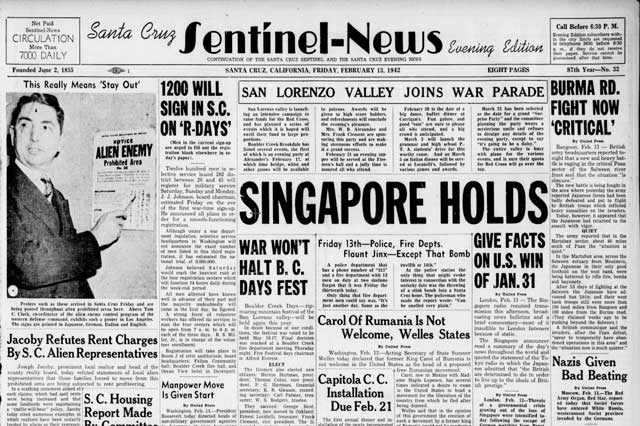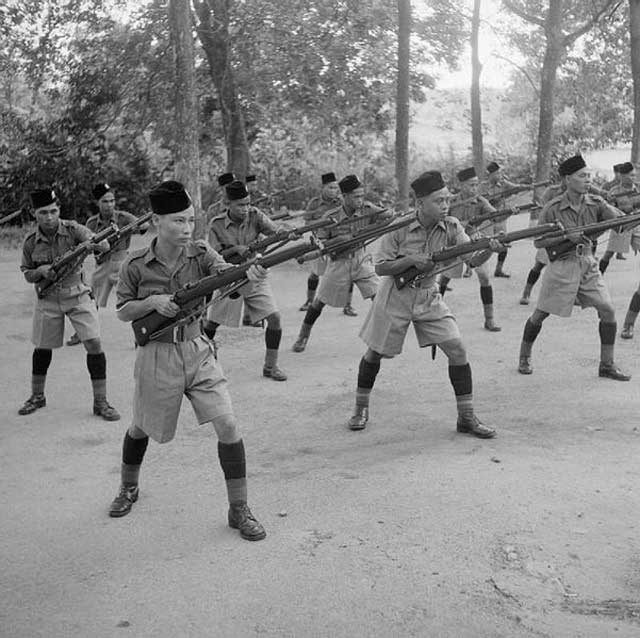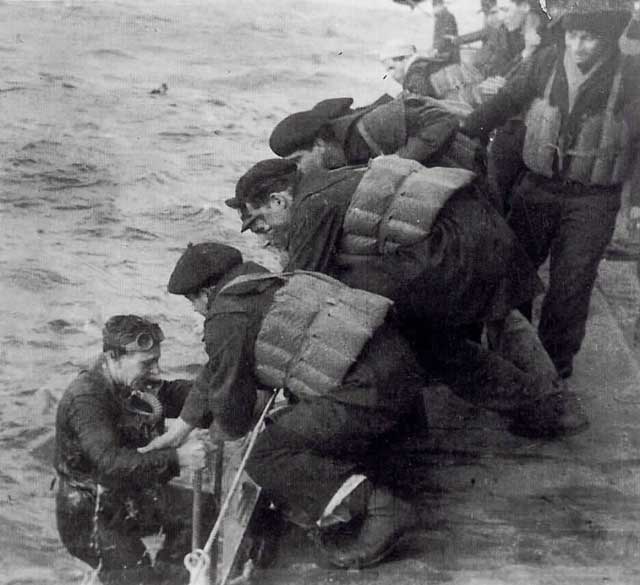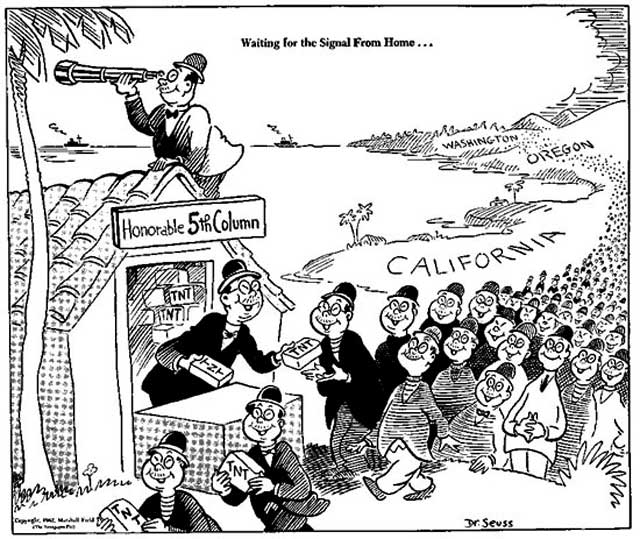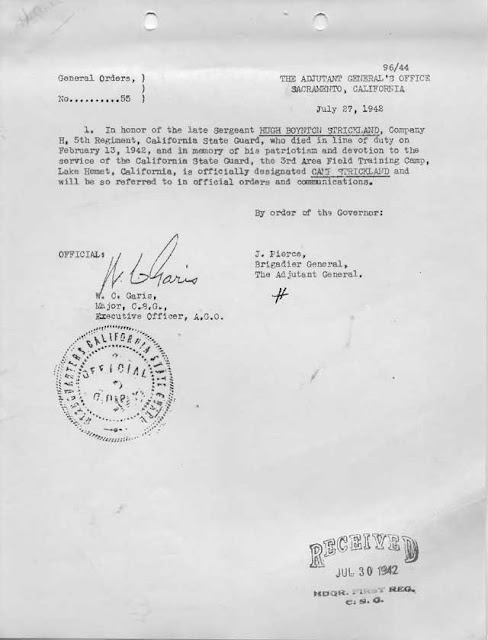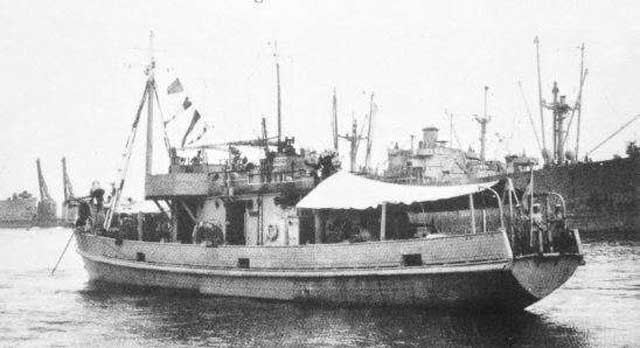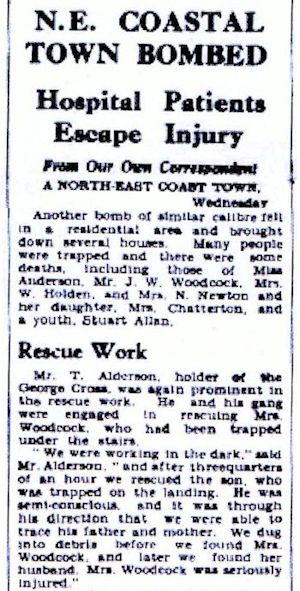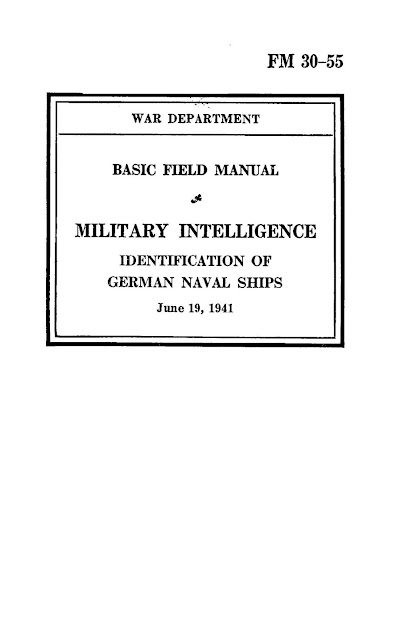Sunday 15 February 1942
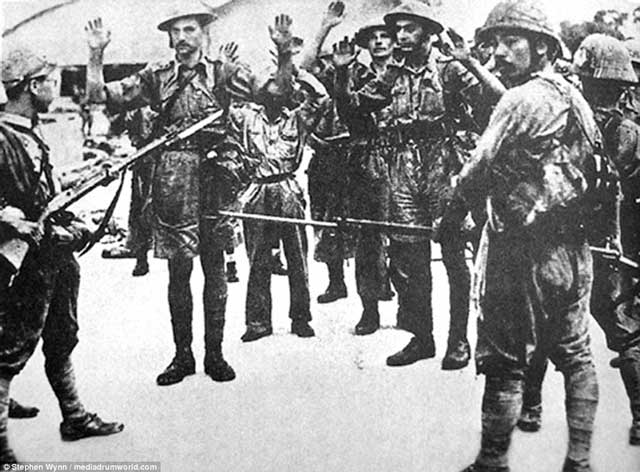 |
| In Singapore, British troops surrender to the Japanese, 15 February 1942 (Daily Mail). |
 |
| Putting a brave face on events in Singapore, the media notes the "desperate attempt to break the stern spirit of the defenders." The People, Sunday 15 February 1942. |
 |
| General Percival (right) leads the surrender parley on 15 February 1942 (Daily Mail). |
 |
| "Java Sea. 15 February 1942. Bomb spray obscures the British cruiser HMS Exeter, as Exeter and the Australian cruiser, HMAS Hobart, manoeuver during a Japanese air attack. Exeter survived this attack to be later sunk in the Java Sea on 1 March 1942 by a torpedo from the Japanese destroyer, Inazuma. HMS Encounter and USS Pope were with the Exeter, and all three ships sunk off the southern coast of Borneo. (Donor J. King)" Australian War Memorial P02620.007. |
 |
| General Yamashita at the surrender of the British garrison of Singapore on 15 February 1942. |
 |
| The Sunday Times notes the "stubbornly maintained" defense at Singapore. February 15, 1942 edition of The Sunday Times. Via NewspaperSG. |
In Bataan, the Philippines, Japanese troops withdraw out of a salient they have driven into the US Army I Corps lines in the western half of the Main Line of Resistance (MLR). There is a small Japanese attack on the eastern half of the Bataan Peninsula in the II Corps sector which is designed to distract the Allies and aid in this evacuation. The Allies have been extremely successful in recent days at eliminating Japanese pockets behind the MLR. This has allowed them to focus more forces on the MLR. However, the Japanese on the other side of the MLR are biding their time, building up their forces and waiting for the right moment to unleash a set-piece offensive.
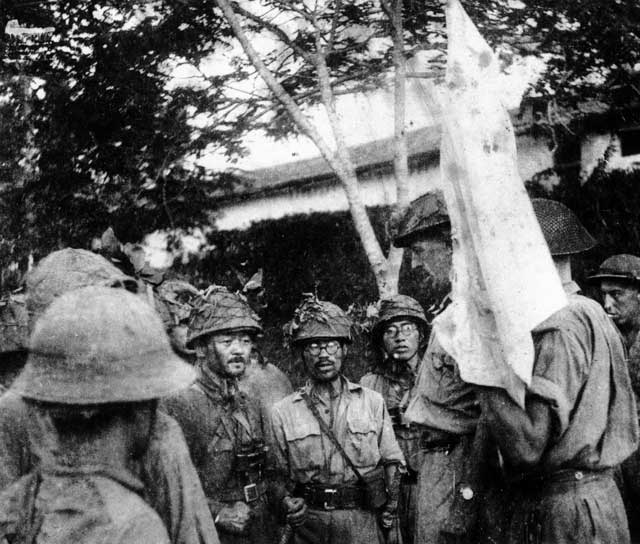 |
| The British surrender Singapore on 15 February 1942. Lieutenant-General Arthur Percival the British commander, is the tall figure just behind the white flag surrounded by Japanese soldiers. |
Japanese submarine HIJMS I-65 torpedoes and sinks 4681-ton Dutch freighter Johanne Justesen off southwest India. There are one death and 58 survivors.
 |
| A captured Soviet T-50 tank, very rare, in Finnish service, 15 February 1942 (SA-Kuva). |
 |
| British Royal Navy anti-submarine vessel HMS Mata Hari, sunk at Bangka, Netherlands East Indies on 15 February 1942. |
ref the new bombing directive: I suppose it is clear the aiming points will be the built-up areas, and not, for instance, the dockyards or aircraft factories where these are mentioned in Appendix A. This must be made quite clear if it is not already understood.This clarification makes clear that bombing efforts henceforth are, in the absence of specified targets, to be directed at the hearts of civilian population centers.
The Luftwaffe continues its raids against British shipping, bombing and damaging 489-ton British coaster Empire Head about 11 nautical miles (20 km) east of Hartlepool. It proceeds to Middlesbrough for repairs.
RAF Bomber Command sends 20 Whitley and 6 Halifax bombers against the U-boat base of St. Nazaire. The conditions are cloudy, and only 9 of the bomber crews even attempt to bomb the target. There are no losses until the bombers return to England to land and three are lost due to the poor weather.
 |
| Greek freighter Meropi, sunk on 15 February 1942. |
U-98 (Kptlt. Robert Gysae), on its sixth patrol out of St. Nazaire, torpedoes and sinks 5298-ton freighter Biela southwest of Newfoundland. The freighter is part of Convoy ON-62. All 50 men on board perish.
U-566 (Kptlt. Dietrich Borchert), on its fourth patrol out of Lorient, torpedoes and sinks 4181-ton Greek freighter Meropi south of Nova Scotia. Meropi is part of Convoy ON-62 but is a straggler. There are 24 dead and 15 survivors.
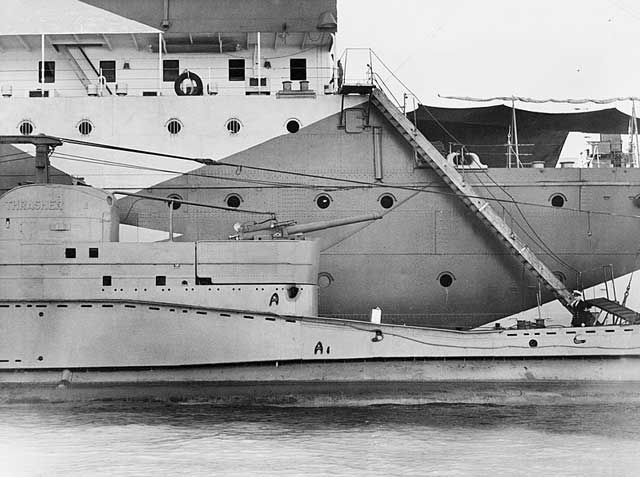 |
| HMS Thrasher on its return to port after sustaining bomb damage in the Mediterranean. The letters indicate damage. 15 or 16 February 1942. © IWM (A 8711). |
 |
| Lieutenant Adnan Bin Saidi, who perished at Singapore on 15 February 1942. |
US/Canadian Relations: US President Franklin Roosevelt makes a radio broadcast directed specifically to Canadians. In he, he praises the country, saying:
Yours are the achievements of a great nation. They require no praise from me-but they get that praise from me nevertheless. I understate the case when I say that we, in this country, contemplating what you have done, and the spirit in which you have done it, are proud to be your neighbors.This is part of a very calculated United States wartime effort to establish and maintain the best possible relations with its neighbors in North and South America. It is an extension of FDR's "Good Neighbor" policy that he began upon his assumption of office in 1933.
 |
| Lieutenant-General Arthur Percival, the British commander in Singapore (Daily Mail). |
American Homefront: The United States Department of Justice technically begins enforcing "Category A" areas. These are locations in Arizona, California, Oregon, and Washington which now are prohibited to enemy aliens. Entire cities in Oregon and Washington are included, but only certain counties in California (including Los Angeles County). However, there remains great disagreement within the higher reaches of the United States government as to how to implement these bans, including who is covered by the bans and what personnel will enforce them. For the time being, the bans are not enforced. Everyone, however, expects a final decision shortly.
 |
| Lobby card for "To Be Or Not To Be" (1942). |
Future History: Sherry D. Jackson is born in Wendell, Gooding County, Idaho. She becomes an actress who appears as one of the children in the 1950s "Ma and Pa Kettle" movies. In 1953, she is cast as the oldest daughter in "The Danny Thomas Show" (aka "Make Room For Daddy"), which runs for five years. She becomes a guest star in numerous classic 1960s and 1970s television series, including "My Three Sons," "Star Trek," and "Batman." Sherry Jackson is retired as of 2019.
Glyn Thomas Johns is born in Epsom, Surrey, England. He becomes one of the great sound engineers of the rock era. After learning his craft at IBC Studios in Portland Place, London, Johns becomes famous for his work on The Beatles' "Get Back" sessions in early 1969. Johns records the songs that become the "Let It Be" album in 1970 before they are turned over to Phil Spector for refinement. He then goes on to work with The Who, Eagles, Led Zeppelin, and many, many other famous acts as an engineer and sometimes producer. Johns develops what becomes known as the "Glyn Johns Method" for recording drums. On 14 April 2012, Johns is inducted into the Rock and Roll Hall of Fame in Cleveland. As of 2021, Glyn Johns still works with top acts such as Eric Clapton.
February 1942
February 1, 1942: The US Navy Strikes Back
February 2, 1942: Germans Recovering in Russia
February 3, 1942: Japanese Shell and Bomb Singapore
February 4, 1942: Battle of Makassar Strait
February 5, 1942: Empress of Asia Sunk
February 6, 1942: The Christmas Island Body
February 7, 1942: The Double-V Campaign
February 8, 1942: Japan Invades Singapore
February 9, 1942: French Liner Normandie Capsizes
February 10, 1942: US Car Production Ends
February 11, 1942: Tomforce Fails on Singapore
February 12, 1942: The Channel Dash
February 13, 1942: Japanese Paratroopers In Action
February 14, 1942: RAF Orders Terror Raids
February 15, 1942: Japan Takes Singapore
February 16, 1942: Operation Neuland Begins
February 17, 1942: Indian Troops Defect to Japanese
February 18, 1942: Battle of Badung Strait
February 19, 1942: FDR Authorizes Internment Camps
February 20, 1942: O'Hare the Hero
February 21, 1942: Crisis in Burma
February 22, 1942: Bomber Harris Takes Over
February 23, 1942: Bombardment of Ellwood, California
February 24, 1942: US Raid on Wake Island
February 25, 1942: Battle of Los Angeles
February 26, 1942: Gneisenau Eliminated
February 27, 1942: Battle of Java Sea
February 28, 1942: Battle of Sunda Strait
2020
 |
| Black Mask Vol XXIV, No 10, February 1942 [Volume 24, Number X]. |
February 1942
February 1, 1942: The US Navy Strikes Back
February 2, 1942: Germans Recovering in Russia
February 3, 1942: Japanese Shell and Bomb Singapore
February 4, 1942: Battle of Makassar Strait
February 5, 1942: Empress of Asia Sunk
February 6, 1942: The Christmas Island Body
February 7, 1942: The Double-V Campaign
February 8, 1942: Japan Invades Singapore
February 9, 1942: French Liner Normandie Capsizes
February 10, 1942: US Car Production Ends
February 11, 1942: Tomforce Fails on Singapore
February 12, 1942: The Channel Dash
February 13, 1942: Japanese Paratroopers In Action
February 14, 1942: RAF Orders Terror Raids
February 15, 1942: Japan Takes Singapore
February 16, 1942: Operation Neuland Begins
February 17, 1942: Indian Troops Defect to Japanese
February 18, 1942: Battle of Badung Strait
February 19, 1942: FDR Authorizes Internment Camps
February 20, 1942: O'Hare the Hero
February 21, 1942: Crisis in Burma
February 22, 1942: Bomber Harris Takes Over
February 23, 1942: Bombardment of Ellwood, California
February 24, 1942: US Raid on Wake Island
February 25, 1942: Battle of Los Angeles
February 26, 1942: Gneisenau Eliminated
February 27, 1942: Battle of Java Sea
February 28, 1942: Battle of Sunda Strait
2020


